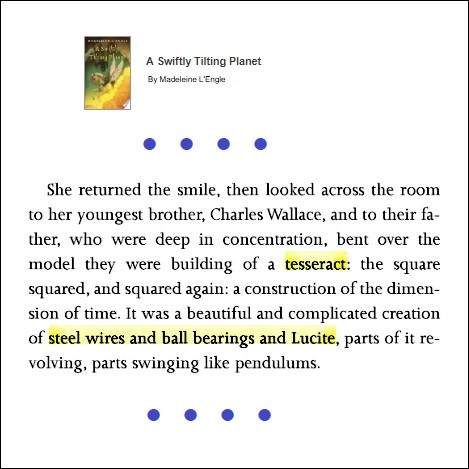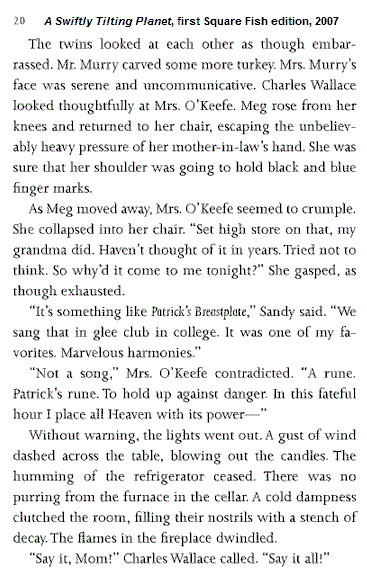"You can work in the undercroft." — Doctor Strange
A related geographical note —
See also "Swiftly Tilting Planet" in this journal.
"You can work in the undercroft." — Doctor Strange
A related geographical note —
See also "Swiftly Tilting Planet" in this journal.

"By an archetype I mean a systematic repertoire
of ideas by means of which a given thinker describes,
by analogical extension , some domain to which
those ideas do not immediately and literally apply."
— Max Black in Models and Metaphors
(Cornell, 1962, p. 241)
"Others … spoke of 'ultimate frames of reference' …."
— Ibid.
A "frame of reference" for the concept four quartets —
A less reputable analogical extension of the same
frame of reference —
Madeleine L'Engle in A Swiftly Tilting Planet :
"… deep in concentration, bent over the model
they were building of a tesseract:
the square squared, and squared again…."
See also the phrase Galois tesseract .
From a Log24 post of March 4, 2008 —
|
SINGER, ISAAC:
"Sets forth his own aims in writing for children and laments
— An Annotated Listing of Criticism
"She returned the smile, then looked across the room to
— A Swiftly Tilting Planet,
For "the dimension of time," see A Fold in Time, Time Fold,
A Swiftly Tilting Planet is a fantasy for children |
Ibid. —
The pen's point:

John Trever, Albuquerque Journal, 2/29/08
Note the figure on the cover of National Review above —

A related figure from Pentagram Design —
See, more generally, Isaac Singer in this journal.
From a scholar quoted in this morning's post —
"Both Vico and Joyce, each in his own way, practice what Vico calls a nuov'arte critica , a 'new critical art'…"
From Hugh Grant's birthday, 2003 (found in a search for whiteness in this morning's post) —
|
Tara Fitzgerald and Hugh Grant |
PATRICK’S RUNE At Tara, in this fateful hour, From A Swiftly Tilting Planet |
The cover of yesterday's Sunday New York Times Book Review
features stylized letters by artist Leonardo Sonnoli that include black
circles and triangles —

The stylized Sonnoli letters spell out "WORDS ABOUT WORDS ABOUT WORDS."
This phrase is used to introduce essays on criticism by "six accomplished critics."
A less accomplished critic might note that in the picture above, Tara is modeling
a new fashion by Sonnoli — namely, the word OOV. A search for this word yields…
"OOV in text processing stands for 'out-of-vocabulary,' i.e., a word
that is not known in the computer's online dictionary."
Addendum (from a link in the same search for whiteness ) in memory of a great beauty who died on Sunday —


John Trever, Albuquerque Journal, 2/29/08
The pen's point:
|
Log24, Dec. 11, 2006
SINGER, ISAAC:
"Sets forth his own aims in writing for children and laments 'slice of life' and chaos in children's literature. Maintains that children like good plots, logic, and clarity, and that they have a concern for 'so-called eternal questions.'"
— An Annotated Listing
"She returned the smile, then looked across the room to her youngest brother, Charles Wallace, and to their father, who were deep in concentration, bent over the model they were building of a tesseract: the square squared, and squared again: a construction of the dimension of time."
— A Swiftly Tilting Planet,
A Swiftly Tilting Planet is a fantasy for children set partly in Vespugia, a fictional country bordered by Chile and Argentina.
|
J. G. Ballard on “the architecture of death“:
“… a huge system of German fortifications that included the Siegfried line, submarine pens and huge flak towers that threatened the surrounding land like lines of Teutonic knights. Almost all had survived the war and seemed to be waiting for the next one, left behind by a race of warrior scientists obsessed with geometry and death.”
— The Guardian, March 20, 2006
“For him, writing is a struggle both with geometry and death.”
— “The Duende,” American Poetry Review, July/August 1999
— Harper’s Magazine review
quoted on back cover of
Cubism and Twentieth-Century Art,
by Robert Rosenblum
(Abrams paperback, 2001)
— An Annotated Listing of Criticism
by Linnea Hendrickson
“She returned the smile, then looked
across the room to her youngest brother,
Charles Wallace, and to their father,
who were deep in concentration, bent
over the model they were building
of a tesseract: the square squared,
and squared again: a construction
of the dimension of time.”
— A Swiftly Tilting Planet,
by Madeleine L’Engle

For “the dimension of time,”
see A Fold in Time,
Time Fold, and
Diamond Theory in 1937.
For a more adult audience —
In memory of General Augusto Pinochet, who died yesterday in Santiago, Chile, a quotation from Federico Garcia Lorca‘s lecture on “the Duende” (Buenos Aires, Argentina, 1933):
Story Theory
The conflict between the Euclidean, or “diamond” theory of truth, and the Trudeau, or “story” theory of truth, continues.
On this, Hugh Grant’s birthday, let us recall last year’s log24 entry for this date. On Roger Ebert’s review of the Hugh Grant film “Sirens” about the artist Norman Lindsay:
Ebert gets Pan wrong in this film; he says, “the bearded Lindsay is a Pan of sorts.” No. The “Pan of sorts” is in fact the girl who romps joyfully with the local boys and who later, with great amusement, uses her divine x-ray vision to view Tara Fitzgerald naked in church.
This year’s offering for Grant’s birthday is an illustrated prayer by a great defender of the religious, or “story,” theory of truth, Madeleine L’Engle:
|
|
PATRICK’S RUNE At Tara, in this fateful hour, From A Swiftly Tilting Planet |
For an uncensored view, see my Harvard weblog. |
|
A Buddhist view —
“Just fancy a scale model of Being
made out of string and cardboard.”
— Nanavira Thera, 1 October 1957,
on a model of Kummer’s Quartic Surface
mentioned by Eddington
A Christian view —

A formal view —
From a Log24 search for High Concept:
See also Galois Tesseract.
Continued from previous post —

For what it's worth…
A birth and a death, each on the Feast of St. Patrick
"Donald Frederick Hornig was born on March 17, 1920, in Milwaukee
and attended Harvard, earning his undergraduate degree there
in 1940 and his Ph.D. in 1943, both in chemistry. His dissertation
was titled 'An Investigation of the Shock Wave Produced by an Explosion'…."
— "Donald Hornig, Last to See First A-Bomb, Dies at 92,"
New York Times print version today (p. A20, New York edition)
A death elsewhere in Wisconsin 92 years later, on March 17, 2012—
Powered by WordPress